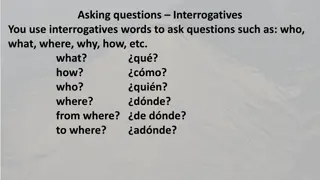
DNS Query Profiles and Resolver Behavior
Explore the interaction between recursive resolvers and DNS root servers, including DNSSEC validation, TCP vs. UDP queries, and IPv6 capabilities. Dive into query traffic patterns and root server responses to gain insights on DNS behavior.
Download Presentation

Please find below an Image/Link to download the presentation.
The content on the website is provided AS IS for your information and personal use only. It may not be sold, licensed, or shared on other websites without obtaining consent from the author. If you encounter any issues during the download, it is possible that the publisher has removed the file from their server.
You are allowed to download the files provided on this website for personal or commercial use, subject to the condition that they are used lawfully. All files are the property of their respective owners.
The content on the website is provided AS IS for your information and personal use only. It may not be sold, licensed, or shared on other websites without obtaining consent from the author.
E N D
Presentation Transcript
Whos Asking? Geoff Huston, Joao Damas APNIC Roy Arends ICANN
Background Experiments that are intended to expose the way in which recursive resolvers interact with the DNS root and its authoritative servers share a common weakness: It isn t possible to trigger a particular response from root servers by varying the contents of the root zone, or by deliberating altering the behaviour of root servers in non-standard ways 2
Background What we can do is create a comparable condition in a delegated zone at a lower point in the DNS name hierarchy to reproduce questions we d like to ask of the root 3
Background What we can do is create a comparable condition in a delegated zone at a lower point in the DNS name hierarchy to reproduce questions we d like to ask of the root What proportion of resolvers perform DNSSEC validation? How many resolvers are capable of asking a query over TCP? What proportion of resolvers are capable of querying using IPv6? How do resolvers handle large DNS responses? 4
Background But are these two environments the same? Does the profile of query traffic seen an an authoritative name server match that seen at an authoritative name server? 5
Root Query Profiles Let s look at the profile of query traffic sent to a number root servers in the period January March 2017 6
Root Query Profile Queries of the Root Zone itself: Queries about delegated Zones: Queries about non-existent Zones: 3.4% 30.3% 66.3% Most of the queries directed to root servers appear to relate to non- existant names (NXDOMAIN) This does not include consideration of the validity of the 2ld (or deeper) in queries to delegated zones, so the junk ratio of queries seen at root servers is likely to be well in excess of 66% 7
Root Query Profile TCP vs UDP: UDP Queries: TCP Queries: 98.3% 1.7% 8
Root Query Profile TCP vs UDP: UDP Queries: TCP Queries: 98.3% 1.7% There is an open question here whether this TCP query rate is a result of a prior query using no or a small EDNS(0) UDP Buffer size and receiving a truncated UDP response, or whether the resolver has chosen to use TCP without a prior UDP query and truncated response 9
Root Query Profile DNS over IPv4 vs DNS over IPv6: Queries over IPv4: Queries over IPv6: 84.3% 15.7% 10
Root Query Profile Query Types seen at a root server: A AAAA NS PTR DS SRV SOA TXT MX CNAME DNSKEY ANY 63.6% 21.5% 4.3% 3.4% 2.7% 1.5% 1.1% 0.7% 0.3% 0.3% 0.2% 0.1% 11
Root Query Profile Query Types seen at a root server vs queries seen directed to a root server relating to the root zone itself: Qtype A AAAA NS PTR DS SRV SOA TXT MX CNAME DNSKEY ANY AT? Root 63.6% 21.5% 4.3% 3.4% 2.7% 1.5% 1.1% 0.7% 0.3% 0.3% 0.2% 0.1% TO? Root 2.6% 0.3% 93.7% 0.0% 0.0% 0.0% 1.1% 0.0% 0.0% 0.0% 2.1% 0.1% 12
Resolvers querying the Root 20M unique resolver IP addresses were seen in the analyzed data set 13
Top 20 Queriers Total Share of Queries 0.22% 0.21% 0.17% 0.16% 0.16% 0.15% 0.14% 0.11% 0.11% 0.11% 0.11% 0.10% 0.10% 0.09% 0.09% 0.09% 0.09% 0.09% 0.09% 0.09% NXDOMAIN resp. rate Resolver 199.16.156 212.19.128 129.56.0 213.5.255 213.5.255 116.9.94 62.201.215 129.56.0 104.156.86 2a02:cb80:2110:: 85.62.233 177.74.154 85.62.229 199.59.148 61.164.15 204.194.239 2620:119:13:: 2620:119:13:: 2620:119:13:: 2620:119:13:: AS Name AS13414 - TWITTER - Twitter Inc., US, United States of America AS50482 - KAZAKHTELECOM-AS , KZ Kazakhstan AS327952 - AS-NATCOM, NG Nigeria AS50188 - KOLNET, PL Poland AS50188 - KOLNET, PL Poland AS4134 - CHINANET-BACKBONE No.31,Jin-rong Street, CN China AS44217 IQNETWORKS, IQ Iraq AS327952 - AS-NATCOM, NG Nigeria AS54113 - FASTLY, US United States of America AS43766 - MTC-KSA-AS , SA Saudi Arabia AS12479 - UNI2-AS , ES Spain AS263650 - Clicfacil Computadores, Servisos e Telecomunicate, BR Brazil AS12479 - UNI2-AS , ES Spain AS13414 - TWITTER - Twitter Inc., US, United States of America AS4134 - CHINANET-BACKBONE No.31,Jin-rong Street, CN China AS30607 302-DIRECT-MEDIA-ASN, US United States AS36692 - OPENDNS - OpenDNS, US United States of America AS36692 - OPENDNS - OpenDNS, US United States of America AS36692 - OPENDNS - OpenDNS, US United States of America AS36692 - OPENDNS - OpenDNS, US United States of America 6.9% 0.5% 1.4% 99.8% 99.9% 67.9% 99.3% 1.7% 0.0% 94.5% 100.0% 100.0% 100.0% 6.6% 0.0% 94.2% 94.3% 94.1% 94.0% 94.1% As seen by one root server system over Feb 2017 14
Lets filter out NXDOMAIN queries Some 18M resolvers asked a query that related to either the root zone or a tld that is defined in the root zone (90% of the original resolver set) 17
Top 20 Queriers Total Share of Queries 0.62% 0.61% 0.51% 0.33% 0.33% 0.26% 0.24% 0.22% 0.21% 0.19% 0.18% 0.16% 0.16% 0.16% 0.15% 0.15% 0.15% 0.14% 0.14% 0.14% Root vs TLD Query 3.8% 0.1% 0.3% 0.0% 0.4% 0.0% 3.8% 0.4% 1.3% 1.0% 0.0% 0.0% 0.1% 1.7% 0.0% 0.0% 7.7% 0.7% 0.0% 1.9% Resolver 199.16.156 212.19.128 129.56.0 104.156.86 129.56.0 61.164.15 199.59.148 207.179.70 108.171.129 209.143.22 220.188.114 180.137.252 64.237.48 213.111.4 179.190.28 61.164.15 116.9.94 216.117.191 61.164.15 85.93.93 AS Name AS13414 - TWITTER - Twitter Inc., US AS50482 - KAZAKHTELECOM-AS , KZ AS327952 - AS-NATCOM, NG AS54113 - FASTLY - Fastly, US AS327952 - AS-NATCOM, NG AS4134 - CHINANET-BACKBONE No.31,Jin-rong Street, CN AS13414 - TWITTER - Twitter Inc., US AS14103 - ACDNET-ASN1 - ACD.net, US AS25605 - SCANSAFE - SCANSAFE SERVICES LLC, US AS7106 - OHIOBRIGHTNET - Com Net, Inc., US AS4134 - CHINANET-BACKBONE No.31,Jin-rong Street, CN AS4134 - CHINANET-BACKBONE No.31,Jin-rong Street, CN AS20473 - AS-CHOOPA - Choopa, LLC, US AS39886 - NOMOTECH 53 avenue de la pierre vallee, FR AS52925 - ASCENTY DATA CENTERS LOCATIO E SERVICOS SA, BR AS4134 - CHINANET-BACKBONE No.31,Jin-rong Street, CN AS4134 - CHINANET-BACKBONE No.31,Jin-rong Street, CN AS10843 - AITNET - Advanced Internet Technologies, US AS4134 - CHINANET-BACKBONE No.31,Jin-rong Street, CN AS8972 - PLUSSERVER-AS , DE As seen by one root server system over Feb 2017 18
Measuring the DNS At APNIC the approach we ve used for some years has been to use an online Ad campaign to test a particular DNS behavior across a large volume of end user browsers The tests have included: DNSSEC validation large DNS responses TCP fall back Use of IPv6 Mapping users to the resolvers that they use 20
Similarity The question is how similar are the sets of resolvers that we see in queries generated by the Ads against what is seen by Root Servers? 21
Top 20 Queriers As seen by APNIC DNS servers Resolver 74.125.47.6 74.125.47.13 74.125.47.1 74.125.47.7 74.125.47.9 74.125.47.3 74.125.47.12 74.125.47.2 74.125.47.11 74.125.47.8 74.125.47.10 74.125.47.5 74.125.47.14 74.125.47.4 74.125.47.15 74.125.181.6 74.125.181.12 74.125.181.8 74.125.181.4 74.125.181.7 Share of Queries AS Name 0.23% 0.23% 0.23% 0.23% 0.23% 0.23% 0.23% 0.23% 0.23% 0.23% 0.23% 0.23% 0.23% 0.23% 0.23% 0.22% 0.22% 0.22% 0.22% 0.22% AS15169 - GOOGLE - Google Inc. AS15169 - GOOGLE - Google Inc. AS15169 - GOOGLE - Google Inc. AS15169 - GOOGLE - Google Inc. AS15169 - GOOGLE - Google Inc. AS15169 - GOOGLE - Google Inc. AS15169 - GOOGLE - Google Inc. AS15169 - GOOGLE - Google Inc. AS15169 - GOOGLE - Google Inc. AS15169 - GOOGLE - Google Inc. AS15169 - GOOGLE - Google Inc. AS15169 - GOOGLE - Google Inc. AS15169 - GOOGLE - Google Inc. AS15169 - GOOGLE - Google Inc. AS15169 - GOOGLE - Google Inc. AS15169 - GOOGLE - Google Inc. AS15169 - GOOGLE - Google Inc. AS15169 - GOOGLE - Google Inc. AS15169 - GOOGLE - Google Inc. AS15169 - GOOGLE - Google Inc. 22
Similarity The two data sets are obviously very different! The APNIC data set is generated by presenting end users with unique domain names that are intended to negate any form of DNS caching The root data set is (in theory) a set of cache miss queries So its no surprise that these data sets are quite different 23
Similarity So how can we compare the resolvers seen on these data collections? One approach is to use the experiment s script to direct the end user s resolvers to query the root AND to query our experiment s servers 24
Query Set w.w.w.1du-u2f235731-c113-s1488343227-ib4040201-apnic-test c.14u-u2f235731-c113-s1488343227-ib4040201.ape.dotnxdomain.net. c.14s-u2f235731-c113-s1488343227-ib4040201.ape.dotnxdomain.net. c.1du-u2f235731-c113-s1488343227-ib4040201.ape.dotnxdomain.net. 25
Experiment Query Set w.w.w.1du-u2f235731-c113-s1488343227-ib4040201-apnic-test Query directed to the root c.14u-u2f235731-c113-s1488343227-ib4040201.ape.dotnxdomain.net. c.14s-u2f235731-c113-s1488343227-ib4040201.ape.dotnxdomain.net. c.1du-u2f235731-c113-s1488343227-ib4040201.ape.dotnxdomain.net. Queries directed to the experiment s server These will resolve to a CNAME that redirects the resolver towards a non-existant domain name (that will be seen at a root server) 26
Query Behaviour root server .dotnxdomain.net server resolver browser 27
Query Behaviour root server .dotnxdomain.net server cname response resolver browser 28
Query Behaviour root server .dotnxdomain.net server cname response redirected query resolver browser 29
Query Behaviour root server .dotnxdomain.net server NXDOMAIN response cname response redirected query resolver browser 30
Seen at the APNIC Server 04:40:28.029000 client 153.128.52.x#20314: q: c.14u-u2f235731-c113-s1488343227-ib4040201.ape.dotnxdomain.net. IN AAAA 04:40:28.028924 client 153.128.52.x#20822: q: c.14u-u2f235731-c113-s1488343227-ib4040201.ape.dotnxdomain.net. IN A 04:40:28.025044 client 153.128.52.x#20448: q: c.14s-u2f235731-c113-s1488343227-ib4040201.ape.dotnxdomain.net. IN A 04:40:28.045443 client 153.128.52.x#20069: q: c.1du-u2f235731-c113-s1488343227-ib4040201.ape.dotnxdomain.net. IN A 04:40:28.046542 client 153.128.52.x#20876: q: c.14s-u2f235731-c113-s1488343227-ib4040201.ape.dotnxdomain.net. IN AAAA 04:40:28.057989 client 153.128.52.x#21203: q: c.1du-u2f235731-c113-s1488343227-ib4040201.ape.dotnxdomain.net. IN AAAA The end user appears to be a dual stack-connected device and these queries all generate CNAME responses that redirect the resolver to an undelegated name 31
Seen at a Root Server 04:40:27.980944 IP 153.128.52.x#20983: q: w.w.w.1du-u2f235731-c113-s1488343227-ib4040201-apnic-test. IN AAAA 04:40:27.983060 IP 153.128.52.x#20339: q: w.w.w.1du-u2f235731-c113-s1488343227-ib4040201-apnic-test. IN A 04:40:28.121397 IP 153.128.52.x#20104: q: w.w.w.14u-u2f235731-c113-s1488343227-ib4040201-cname-apnic-test. IN AAAA 04:40:28.146902 IP 153.128.52.x#20336: q: w.w.w.1du-u2f235731-c113-s1488343227-ib4040201-cname-apnic-test. IN A 04:40:28.440938 IP 153.128.52.x#20460: q: w.w.w.14s-u2f235731-c113-s1488343227-ib4040201-cname-apnic-test. IN A 32
Seen at a Root Server 04:40:27.980944 IP 153.128.52.x#20983: q: w.w.w.1du-u2f235731-c113-s1488343227-ib4040201-apnic-test. IN AAAA 04:40:27.983060 IP 153.128.52.x#20339: q: w.w.w.1du-u2f235731-c113-s1488343227-ib4040201-apnic-test. IN A These queries were originally directed to a root 04:40:28.121397 IP 153.128.52.x#20104: q: w.w.w.14u-u2f235731-c113-s1488343227-ib4040201-cname-apnic-test. IN AAAA 04:40:28.146902 IP 153.128.52.x#20336: q: w.w.w.1du-u2f235731-c113-s1488343227-ib4040201-cname-apnic-test. IN A 04:40:28.440938 IP 153.128.52.x#20460: q: w.w.w.14s-u2f235731-c113-s1488343227-ib4040201-cname-apnic-test. IN A CNAME-generated responses that direct the resolver to a root. * * Why are the cname generated queries only for A OR AAAA and not both? 33
Query Ratio Each experiment generates approximately the same number of queries towards a root server as to the experiment s server (5:6) But we are using the logs from a single root server here If resolvers evenly distribute queries across all root server letters over time then we could expect to see a query ratio of 0.08 in the data 34
Query Ratio Average query ratio: 0.06 This slightly less than the anticipated number A possible reason is that the larger resolvers are performing some form of local root zone caching 35
Query Ratio If the resolver is performing NSEC caching, or the resolver is working with a local copy of the root zone (RFC7706), or The resolver has latched onto a different root server letter, Then we should see a far lower query ratio for that resolver 36
Google PDNS Query Ratio Google DNS query ratio: 0.0008 This is around 1/100 of the calculated ratio It is a likely side effect of some form of NSEC caching being performed by Google s resolvers 37
Comcast Resolver Query Rate Comcast DNS query ratio: 0.004 This is 1/20 of the expected query rate either Comcast s resolvers are performing some form of local root zone caching or their resolvers have latched onto a different Root Zone server letter 38
Correlation In a one month period (Feb 17) 10,000 resolvers made 90% of the queries to the experiment servers (out of a total of 375,206 resolver IP addresses) Of these 10,000 resolvers: 8,600 were seen by this root server letter cluster 1,400 were not seen at all by this root server letter (of these 1,116 were IPv6 addresses, indicating a possible IPv6 reachability issue with this root server) 39
Correlation These 8,600 resolvers: Made 75% of the queries seen at the experiment servers Made 87% of the experiment-related queries seen at this root Appear to carry the bulk of the browser level DNS resolution traffic for the Internet 40
Preliminary Findings Most of the resolvers seen at the root appear to make a very small number of queries 99% of the seen resolvers asking queries of the root are responsible for less than 4% of the total query count 10% of the seen resolvers ask only for non-existent domain names This is a very long tail distribution set 41
Preliminary Findings Resolvers who are seen to query at lower levels of the DNS are also likely to be seen by the root servers Although the intensity of queries may differ due to various forms of local root zone content caching The opposite is not necessarily the case, in that resolvers seen to ask queries of the root may not necessarily be observed asking queries of servers at lower levels of the DNS (10% of the seen resolvers were not observed to ask a query about a delegated name) 42
Preliminary Findings Resolvers appear to be less likely to exclusively latch onto a single root letter, and appear to distribute their queries to all root server letters over time 43
Preliminary Findings Some resolvers (and some large scale resolvers) are using either NSEC caching or some form of RFC7706-style of local root zone caching This has dramatically reduced their query rate to root servers for non-existent domain names 44
Preliminary Findings IPv6 still presents some reachability issues for some roots and some resolvers 45
This is work in progress Further questions in this study: Can we map users to the resolvers to root server letter preference (if any)? Can we cast any light on resolver latching to a root service letter? How widespread are the IPv6 connectivity issues? Can we track the uptake of aggressive NSEC caching of the root zone in resolvers? 46















